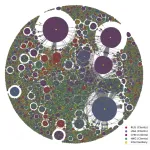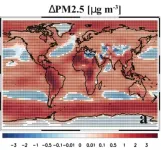(Press-News.org)
NEW YORK, NY (Feb. 28, 2023)—A device that uses ultrasound to calm overactive nerves in the kidneys may be able to help some people get their blood pressure under control.
A new study led by researchers at Columbia University and Université de Paris, France, has found that the device consistently reduced daytime ambulatory blood pressure by an average of 8.5 points among middle-aged people with hypertension.
Doctors usually prescribe lifestyle changes, such as reducing salt intake or losing weight, and medications to lower blood pressure in patients with hypertension. Yet about one-third of hypertensive patients are unable to control their blood pressure despite these interventions.
“Many patients in our clinical practice are just like the patients in our study, with uncontrolled blood pressure in the 150s despite some efforts,” says Ajay Kirtane, MD, professor of medicine at Columbia University Vagelos College of Physicians and Surgeons and co-leader of the study.
Leaving blood pressure uncontrolled for too long can lead to heart failure, strokes, heart attacks, and irreversible kidney damage.
“Renal ultrasound could be offered to patients who are unable to get their blood pressure under control after trying lifestyle changes and drug therapy, before these events occur,” says Kirtane, who is also an interventional cardiologist and director of cardiac catheterization laboratories at NewYork-Presbyterian/Columbia University Irving Medical Center.
The results of the study, published in JAMA Cardiology, tested the device, which is used in an outpatient procedure called ultrasound renal denervation. The device is still investigational and has not yet been approved by the FDA for use outside of clinical trials.
Kidney nerves and hypertension
Hypertension in middle age is thought to be caused in part by overactive nerves in the kidneys, which trigger water and sodium retention and release hormones that can raise blood pressure. (In older people, hypertension often occurs as blood vessels stiffen). Antihypertensive drugs work in different ways to lower blood pressure, by dilating blood vessels, removing excess fluid, or blocking hormones that raise blood pressure. But none of these medications target the renal nerves directly.
Ultrasound therapy calms overactive nerves in the renal artery, disrupting signals that lead to hypertension. The therapy is delivered to the nerves via a thin catheter that is inserted into a vein in the leg or wrist and threaded to the kidney.
Study results
The new study pooled data from three randomized trials encompassing more than 500 middle-aged patients with varying degrees of hypertension and medication use.
Twice as many patients who received the ultrasound therapy reached their target daytime blood pressure (less than 135/85 mmHg) compared to patients in the sham groups.
"The result was almost identical across the different study groups, which definitively shows that the device can lower blood pressure in a broad range of patients,” Kirtane says.
The procedure was well-tolerated, and most patients were discharged from the hospital the same day. According to Kirtane, improvements in blood pressure were seen as soon as one month after the procedure.
The treatment will be evaluated by the FDA in the coming months.
Bottom line for patients with resistant hypertension
The investigators expect the treatment could be offered as an adjunct to medication therapy and lifestyle changes for patients with uncontrolled hypertension.
“Once the device is available, we envision recommending it to patients who have tried other therapies first. The hope is that by controlling blood pressure, we might be able to prevent kidney damage and other effects of uncontrolled blood pressure,” Kirtane adds.
More information
The study, titled “Patient-Level Pooled Analysis of Ultrasound Renal Denervation in the Sham-Controlled RADIANCE II, RADIANCE-HTN SOLO and RADIANCE-HTN TRIO Trials," was published on February 28 in JAMA Cardiology. The study includes data from the RADIANCE II trial, which was published simultaneously in JAMA and was also co-led by Kirtane.
###
Columbia University Irving Medical Center
Columbia University Irving Medical Center (CUIMC) is a clinical, research, and educational campus located in New York City, and is one of the oldest academic medical centers in the United States. CUIMC is home to four professional colleges and schools (Vagelos College of Physicians and Surgeons, Mailman School of Public Health, College of Dental Medicine, and School of Nursing) that are global leaders in their fields. CUIMC is committed to providing inclusive and equitable health and medical education, scientific research, and patient care, and working together with our local upper Manhattan community—one of New York City's most diverse neighborhoods. For more information, please visit cuimc.columbia.edu.
END
COLUMBUS, Ohio – Immune cells that keep the brain free of debris but also contribute to inflammation are the likely culprits behind the concentration and memory problems that sometimes follow one type of chemotherapy, a new study in mice suggests.
Researchers previously showed that female mice given paclitaxel, a drug commonly used to treat breast, ovarian and other cancers, developed memory problems that were linked to inflammation in the brain. Mice receiving a placebo did not develop the “mental fog” phenomenon known as chemo brain.
In this study, the team used a technique to delete immune cells called microglia from the brains ...
From astronomical sums of money to opulent superyachts and lavish villas, the assets of the oligarchs providing the political and financial backing for Russian president Vladimir Putin's military ambitions have been publicly and fervently seized by Western nations since Russia's invasion of Ukraine.
Yet, the invasion—now in its second year—remains largely unabated as Russia's moneyed elite challenge sanctions in court or simply dodge them.
But a new study led by Dartmouth College researchers exposes a massive vulnerability for the Kremlin's critical cadre of billionaires—the small, secretive network of financial experts ...
With the development of human space technology, planetary exploration has become one of the most important space exploration activities of mankind. As of December 2021, a total of 252 planetary probes have been launched around the world. The missions reveal the deep space to humankind. In the new paper published in the journal Space: Science & Technology, Yixin Sun et al review some advances in planetary science made by these missions in the past years.
1.Research Advances in Terrestrial Planets
1. ...
COLUMBUS, Ohio – Using data from the James Webb Space Telescope’s first year of interstellar observation, an international team of researchers was able to serendipitously view an exploding supernova in a faraway spiral galaxy.
The study, published recently in The Astrophysical Journal Letters, provides new infrared measurements of one of the brightest galaxies in our cosmic neighborhood, NGC 1566, also known as the Spanish Dancer. Located about 40 million miles away from Earth, the galaxy’s extremely active center has led it to become especially popular with scientists aiming to learn more about how star-forming nebulae form and evolve.
In this case, ...
Following a successful pilot study, an online anonymous treatment program aimed at reducing child sexual abuse by providing treatment to individuals who exhibit sexual urges towards children is being launched across the EU. It is now available in Swedish, German, and Portuguese as well as in an updated English version. The treatment program, which has been developed by researchers and psychologists at Karolinska Institutet in Sweden, will be evaluated within the framework of an international research collaboration funded by the EU.
"Sexual exploitation of children is a major problem within ...
PULLMAN, Wash – A liquid nitrogen spray developed by Washington State University researchers can remove almost all of the simulated moon dust from a space suit, potentially solving what is a significant challenge for future moon-landing astronauts.
The sprayer removed more than 98% of moon dust simulant in a vacuum environment with minimal damage to spacesuits, performing better than any techniques that have been investigated previously. The researchers report on their work in the journal, Acta Astronautica.
While people have managed ...
LEAWOOD, Kansas—Articles appearing in an Annals of Family Medicine special supplement published yesterday contain observations, insights, and ideas for advancing health care equity, promoting interprofessional collaboration, transforming education, and improving primary care practices.
The supplement, titled, “Advancing Primary Care through Research, Education and Practice: Work of the Health Resources and Services Administration–Supported Academic Units for Primary Care Training and Enhancement,” highlights activities of six HRSA-funded academic units for primary care training enhancement. ...
Not all pollution comes from people. When global temperatures increase by 4 degrees Celsius, harmful plant emissions and dust will also increase by as much as 14 percent, according to new UC Riverside research.
The research does not account for a simultaneous increase in human-made sources of air pollution, which has already been predicted by other studies.
“We are not looking at human emissions of air pollution, because we can change what we emit,” said James Gomez, UCR doctoral student and lead author of the study. “We can ...
Artificial intelligence (AI) has long been inspired by the human brain. This approach proved highly successful: AI boasts impressive achievements – from diagnosing medical conditions to composing poetry. Still, the original model continues to outperform machines in many ways. This is why, for example, we can ‘prove our humanity’ with trivial image tests online. What if instead of trying to make AI more brain-like, we went straight to the source?
Scientists across multiple disciplines ...
The word ‘evolution’ may bring to mind dusty dinosaur bones, but it impacts our health every day. For example, even though antibiotics were invented only a century ago, the evolution of antibiotic resistance is already a major concern. The rise in modern health problems such as obesity can also be traced back to evolutionary principles.
An article published in Frontiers in Science demonstrates how applying an evolutionary perspective to medicine can inspire new ways of preventing and treating disease.
“Evolutionary medicine holds promise to transform our understanding of why we get sick ...




